PARTY GAMES
FOR KIDS
3 to13 years
Contents
Symbols
 Spontaneous games games that can be played on the spot, no preparation needed.
Spontaneous games games that can be played on the spot, no preparation needed.
 Games that have no winner and therefore need no prizes. The majority of these games can be restarted and played again.
Games that have no winner and therefore need no prizes. The majority of these games can be restarted and played again.
 Games that need to be played outside.
Games that need to be played outside.
 Team games players have to form teams.
Team games players have to form teams.
 Idea symbol explains a slight variation of how to play a game such as what you can do for younger or older children.
Idea symbol explains a slight variation of how to play a game such as what you can do for younger or older children.
Introduction
Games are fun and provide all the laughter and entertainment that you need. Children hang out for parties not just for the cake, but also to play games. Theres no other time of year where you get together with friends and bash a pi ata, pop balloons to get lollies out, or see how silly your friends look with their tongues poking out, covered in rice bubbles.
This book will provide your children with a bucket-load of games that can be played year after year. Youll never have to rack your brains or be stuck for a game again.
And you dont have to limit playing these games to childrens birthday parties.
These games can be played with friends or neighbors on the weekend. Or there are many family occasions where both adults and children can play together. Can you imagine Grandma chewing bubblegum and trying to blow a bubble or Aunt Marge cackling like a witch? For your next family barbeque or birthday dinner, why not flick through and find a few games that can be enjoyed by the whole family?
Everyone will have a ball, maybe even a tear or two of laughter. After all, were really all children at heart.
About this book
These games are intended for ages 3 to 13, but the age grouping is only a guide. You are the best person to decide whether your children are able to play certain games or not, depending on their skills and level of development. When looking to find a game, e.g. for a 10-year-olds party, dont dismiss games that are for ages 3 13 years. These games are adaptable for most ages.
There are many old favorites as well as fresh new games. These are games that I have played with my own children, friends and family. You can call the games whatever you like. You might even want to change or play certain games differently to make them better for you. Or you might like to adapt some games to suit your childs age group.
Games that have a  love heart symbol next them are spontaneous games. Busy parents will love these games, as they require no preparation. They can be played on the spot without having to organize any special materials, allowing you to spontaneously use whatever is at hand. These are great for parents who havent had time to organize any games until the actual day or even when the children arrive.
love heart symbol next them are spontaneous games. Busy parents will love these games, as they require no preparation. They can be played on the spot without having to organize any special materials, allowing you to spontaneously use whatever is at hand. These are great for parents who havent had time to organize any games until the actual day or even when the children arrive.
Games that have a  cross next to them are games that have no winner, and therefore need no prizes. The majority of these games can be restarted and played again.
cross next to them are games that have no winner, and therefore need no prizes. The majority of these games can be restarted and played again.
Games that need to be played outside have a  sun next to them. Games that are played in teams have a
sun next to them. Games that are played in teams have a  team symbol. For most games, if a team game has an uneven number of players, one player can be chosen to go twice.
team symbol. For most games, if a team game has an uneven number of players, one player can be chosen to go twice.
 The idea symbol may explain a slight variation of how to play a game such as what you can do for younger or older children.
The idea symbol may explain a slight variation of how to play a game such as what you can do for younger or older children.
A quick flip to the back of the book will show you that there are two indexes. One is organized, for quick reference, under chapter headings. The other is by the names of the games themselves.
I hope these games stimulate the party-givers imagination and bring you as much enjoyment as they have to my family and friends.
Tammy Archibald
Games
So youve bitten the bullet and promised your child a party. Now youre beginning to wonder just what you have committed yourself to. Theres an easy way to get through this without losing your marbles. Armed with this book, you will be able to choose the right games for your childs party.
When organizing games for a party, the three most important questions you need to ask yourself are:
How old is the child?
How many people am I inviting?
Will the party be inside or outside, or a bit of both?
Once you have the answer to these questions, it will be much easier to select and organize the games that you would like to play.
For young children of 3 to 5 years, choose games that everyone can be involved in or where each has a turn. Have mostly simple games that are easy to play. Try to avoid games where people get out each time or where they have to wait a long time for their turn.
Older children (9 and upwards) seem to go through games fast and want to keep playing game after game. Younger children still love playing with their friends, so include time for free play.
Choose games that children are capable of playing without too much assistance from you.
If having an outside party, choose some games that can be played inside as well, just in case it rains on the day.
When choosing games for an inside party, have a mixture of sitting, standing, and moving games, as some children dont like sitting still for too long.
Try not to choose all quick games. Have one or two games that go for a while. Otherwise the games will be over in no time with the children still wanting more. However, dont let a game drag on for too long unless the children are really enjoying it. About 10 minutes is long enough for a game.
Try not to have too many complicated games where you constantly have to explain the rules. Try to keep the instructions as simple as possible. Its exhausting having to talk over everyone. If you do have to explain, gather everyone together beforehand so you dont have to shout.
If you dont know many of the children at the party, you might like to have nametags for them to stick to their shirt. This will make it easier for you when playing games and during the party.
For certain games, you might need a practice or two to show the children how to play.
You can adapt the rules of a game to suit the age group, and if you find a game isnt working, change quickly to another.
When choosing someone to go first in a game, dont forget about the birthday boy/girl. This is their special day; they should be the center of attention. Spoil them and let them start first if they wish.
Dont force anyone to play a game; if they want to, let them just watch.
All games will need adult supervision at all times.
Some game categories will occasionally overlap, e.g. a game that involves a ball and blindfold. These games will only be found in one of the categories, not both.
Remember: games can be played just for fun . Children can play with each other rather than against one another. There neednt always be winners and losers. If you do have a winner, everyone can clap and cheer for that person or just restart the game.
The number of games to have depends on how long the party runs (from my experience 2 hours is perfect unless its a sleepover for older children). I find a good guide to determine this is the Age Game Method. However old the birthday boy/girl is turning, that is how many main games you play, with some spare games up your sleeve (about four) that dont require prizes, but are just fun to play. Take your cue from how the party is going.
Next page
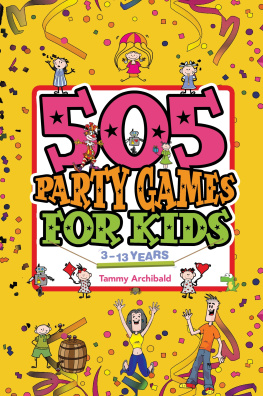
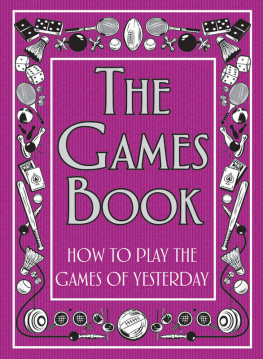
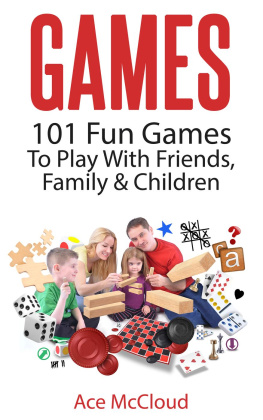


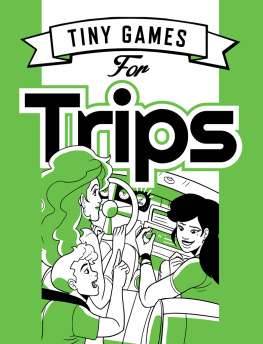
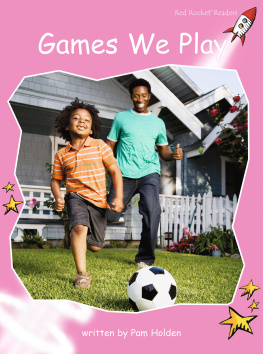
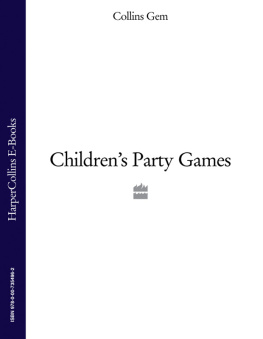
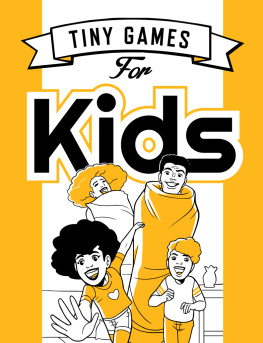
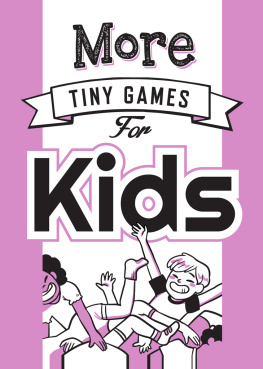

 Spontaneous games games that can be played on the spot, no preparation needed.
Spontaneous games games that can be played on the spot, no preparation needed. Games that have no winner and therefore need no prizes. The majority of these games can be restarted and played again.
Games that have no winner and therefore need no prizes. The majority of these games can be restarted and played again. Games that need to be played outside.
Games that need to be played outside. Team games players have to form teams.
Team games players have to form teams. Idea symbol explains a slight variation of how to play a game such as what you can do for younger or older children.
Idea symbol explains a slight variation of how to play a game such as what you can do for younger or older children. love heart symbol next them are spontaneous games. Busy parents will love these games, as they require no preparation. They can be played on the spot without having to organize any special materials, allowing you to spontaneously use whatever is at hand. These are great for parents who havent had time to organize any games until the actual day or even when the children arrive.
love heart symbol next them are spontaneous games. Busy parents will love these games, as they require no preparation. They can be played on the spot without having to organize any special materials, allowing you to spontaneously use whatever is at hand. These are great for parents who havent had time to organize any games until the actual day or even when the children arrive. cross next to them are games that have no winner, and therefore need no prizes. The majority of these games can be restarted and played again.
cross next to them are games that have no winner, and therefore need no prizes. The majority of these games can be restarted and played again. sun next to them. Games that are played in teams have a
sun next to them. Games that are played in teams have a  team symbol. For most games, if a team game has an uneven number of players, one player can be chosen to go twice.
team symbol. For most games, if a team game has an uneven number of players, one player can be chosen to go twice. The idea symbol may explain a slight variation of how to play a game such as what you can do for younger or older children.
The idea symbol may explain a slight variation of how to play a game such as what you can do for younger or older children.